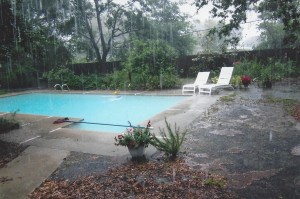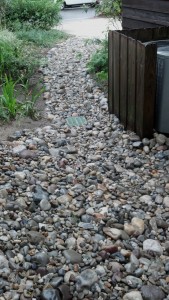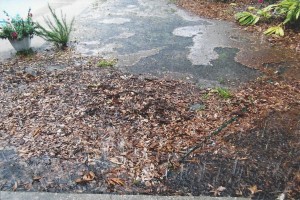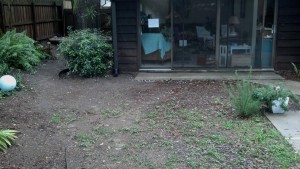Over the last couple of weeks, as the rainy season began in Central Florida, we got several calls a week from people who have moderate to severe drainage issues. Improper or insufficient drainage on your property can mean big and expensive improvements over the years if they are not dealt with early and appropriately. Trust me, an investment on your part today will save you double or even triple the cost a few years from now. Since we have been getting so many calls on the topic, we have written a short blog detailing the causes of drainage issues and a few typical solutions that we use here at John Madison Landscape.
Indications of Drainage Issues
There are obvious signs that you have a drainage problem, such as, standing water in your backyard for days after a rain event or water leaking into your house from the patio when it rains. These are serious conditions that should be taken care of as soon as possible, especially if it involves a structure. In addition, if you have sand or soil build up on hardscape, such as your patio or sidewalk, or if your plant material is yellowing, it could be a sign that there is improper subsurface drainage.
Causes of Drainage Problems
There are two main causes for drainage problems. The first is grading. This is by far the biggest culprit of standing water or water that goes where it does not belong. Water seeks out the area of lowest elevation and will travel long distances to find such an area. To demonstrate this point, consider the St. John’s River. It is one of only a handful of rivers in North America to flow north. This 310 mile river flows from Central Florida to Jacksonville and the difference in elevation from its headwaters to the mouth of the river is only 30 feet.
The second cause is soil compaction, which simply means that the small spaces between soil particles that allow water to percolate below the soil have been greatly diminished, leaving water nowhere to go. Because Florida has mostly sandy, well-drained soils, this is rarely a major issue, unless you live in an area where a lot of construction has taken place with large trucks driving over the soil. If you happen to live in one of the few areas in the state with clay or loamy soil as opposed to sandy soil, keep in mind that these soil particles are much smaller than sandy soil and, therefore, offer less room between particles for water to move. You will most likely have more severe and/or complex drainage issues.
Solutions to Drainage Problems
Firstly, keep in mind that drainage solutions are unique so not every type of drainage resolution is explained in this blog. Secondly, every type of drainage solution does 3 things: collect, transport, and then discharge the water. There are two types of drainage solutions: surface and subsurface. Surface solutions mainly involve regrading and utilizing swales. This approach alters the elevation of your yard to move water to a specific location. Swales are drainage channels that move water to a collection point. This is often the least expensive option but it is also the least permanent. In some situations, erosion can occur overtime and if the grade is ever altered, you would be facing drainage issues again.
Most drainage problems are solved using subsurface drainage, which is usually more expensive but much more reliable and efficient. There are different solutions depending on the surface you are trying to drain. Impervious surfaces, like a patio or driveway, are usually drained using a non-perforated (solid) pipe and catch basin system or a channel drain. When constructing a new hardscape, the area should be graded in a manner that directs the water to a catch basin. If you have an existing hardscape, like a driveway that drains toward your house, a channel drain can be inserted between the driveway and your garage that will collect the water, preventing your garage from flooding. Once the water reaches these collection points, it can than be transported to an appropriate discharge location.
Septic Tank & Sewer Solutions provides rescual from all your drainage and sewer problems. Check out their services today.
If you are trying to drain a pervious surface, like your yard, the best solution is typically a French drain. This drain consists of a perforated pipe (a pipe with small openings that allow for water to seep in), a sleeve, and drainage rock. The way a French drain works is fairly simple. During construction, your yard is regraded so that water is directed to a trench filled with rock and a pipe, inserted below ground in the trench. When it rains, water percolates into the soil, moves into the trench, entering the pipe through the small holes. The pipe carries the water quickly to an appropriate place for discharge, such as a storm drain. The sleeve and drainage rock are essential to ensure the long term efficiency of the drain. The sleeve is a mesh-like material that covers the pipe. This mesh helps keep the holes from clogging up with soil and dirt. Without the sleeve, over time the holes would be clogged with dirt, making the pipe non-functional. The rock provides for the quick movement of water to the pipe below. Without the rock, water would percolate much more slowly, leading to standing water in your yard, which makes the pipe somewhat useless below grade if the water cannot reach it or cannot reach it quickly enough to drain your yard.
We recently completed a large scale drainage project at a home near Downtown Orlando. Before construction, the owner’s backyard and pool would overflow with water every time it rained heavily and the water would stay for hours, even days. After construction, we stopped by on a rainy day and we found no standing water. Here are a few photos from this project so you can see how efficient the French drain system actually is:

Before




0 Comments